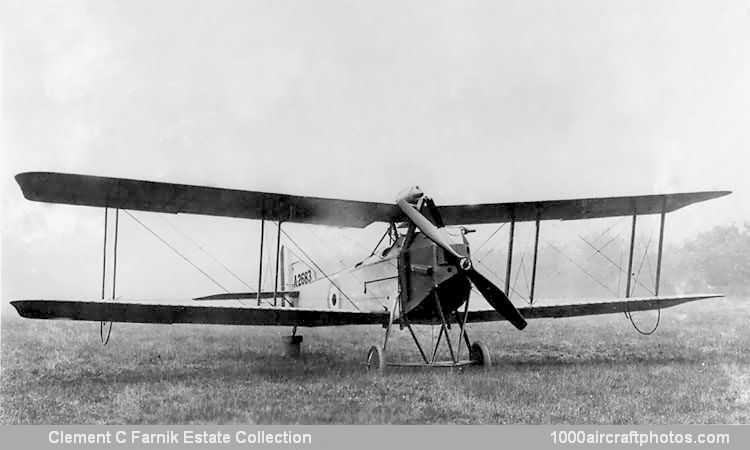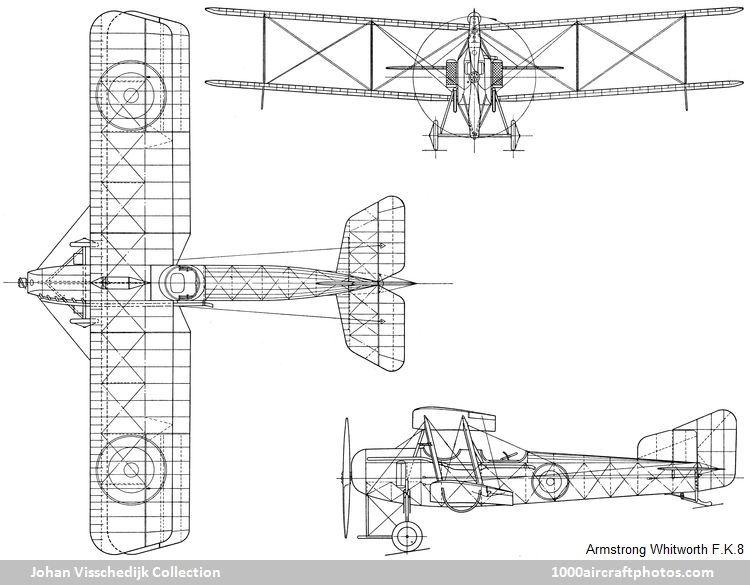Like the F.K.3 the F.K.8 was of wooden construction and was initially fitted with an 120 hp Beardmore engine, soon replaced by a 160 hp Beardmore engine. Orders for 1,580 series aircraft were placed with Armstrong Whitworth (680) and Angus Sanderson & Co. at Newcastle-on-Tyne (900) and in late 1916 the first series aircraft were delivered. Production expired in July 1918, after approximately 1,500 F.K.8s had been built.
In January 1917 the F.K.8 came in service with the RFC at the western front with No. 35 Squadron and subsequently with Nos.2, 8, 10 and 82 Squadrons. In the UK No. 50 Sq. (Home Defence) got the F.K.8, while the squadrons Nos.17 and 47 in Macedonia and No. 142 in Palestine were partly equipped with the type. The F.K.8 was used as tactical and artillery patrol and (night) bomber.
The F.K.8 was not fast, heavy on the controls and fairly unwieldy, but could nevertheless give excellent party in an air fight, in contrast to most British two-seaters (B.E.2 and R.E.8), which were practically defenseless against whatever type. It was of solid construction and fitted with a fixed synchronized machine gun in the nose and a flexible mounted machine gun in the rear cockpit, and only a few F.K.8s were lost in aerial combats. The type soon became popular among its crews, and the F.K.8 earned respect from German pilots.
On November 29, 1917, while on a photo-reconnaissance flight over the front line near Zonnebeke, Belgium, an F.K.8 (s/n B324) of No. 10 Squadron, crewed by Captain J.A. Pattern (pilot) and Lieutenant P.W. Leycester (observer/gunner), was attacked by an Albatros Scout flown by the German fighter ace Leutnant (Lieutenant) Erwin Böhme (24 victories), commander of Jagdstaffel 2. The fight is told by Pattern in the book "Army Wings: A History of Army Air Observation Flying 1914-1960" by Robert Jackson:
"About a quarter of a mile on the enemy side of the lines, I turned south-east and Leycester started to work his camera. The anti-aircraft fire, which had been intense, had stopped, but I didn't take much notice. I should have known better; it was a sure sign that enemy fighters were in the vicinity. Suddenly, I heard the clatter of Leycester's machine gun above the roar of the engine. I looked round to see what he was shooting at, and nearly had a heart attack. Slanting down from above, getting nicely into position thirty yards behind my tail, was an Albatros.
I immediately heaved the aircraft round in a 'split-arse' turn, tighter I think than I had ever turned before. I felt a flash of panic as I lost sight of the Hun, but Leycester must have been able to see him all right as he kept on firing. My sudden turn had done the trick, the Albatros overshot and suddenly appeared right in front of me. Because of the relative motion of our two aircraft, he seemed to hang motionless, suspended in mid-air, and I could see the pilot's face as he looked back at me.
I sent a two-second burst of Vickers fire into him, his aircraft seemed to flutter, then slid out of sight below my starboard wing. I was pretty certain that I had hit his petrol tank. Behind me, Leycester was still blazing away. He was using tracer, and it may have been one of his bullets that ignited the petrol pouring from the Hun's ruptured tank.
When I caught sight of the Albatros again, it was burning like a torch and side-slipping towards the ground, trailing a streamer of smoke. For an instant I saw the German pilot, looking down over the side of the cockpit. Then the smoke and flames enveloped him. I pushed the aircraft nose down and headed flat out for home, aware that the other Hun scouts were coming after me. They would probably have got me, too, if some friendly fighters had not come along just in time and driven them away. To say I was relieved would be the understatement of the century."
Shortly after the Armistice in November 1918 the FK-8s were struck off the RAF inventory, a few came on the civil market. Two examples, fitted with seats for two passengers, were still used in 1922 on one of the first regulated airlines in Australia."

